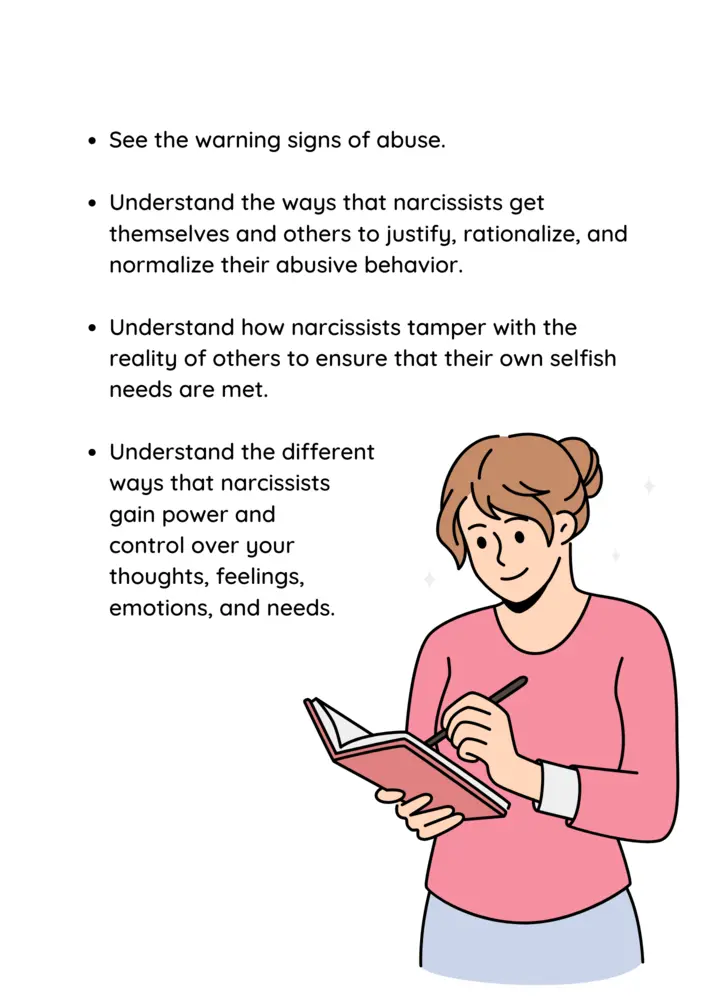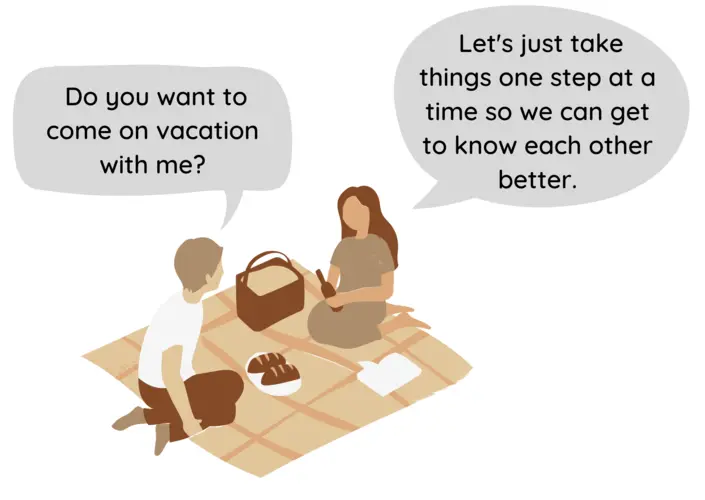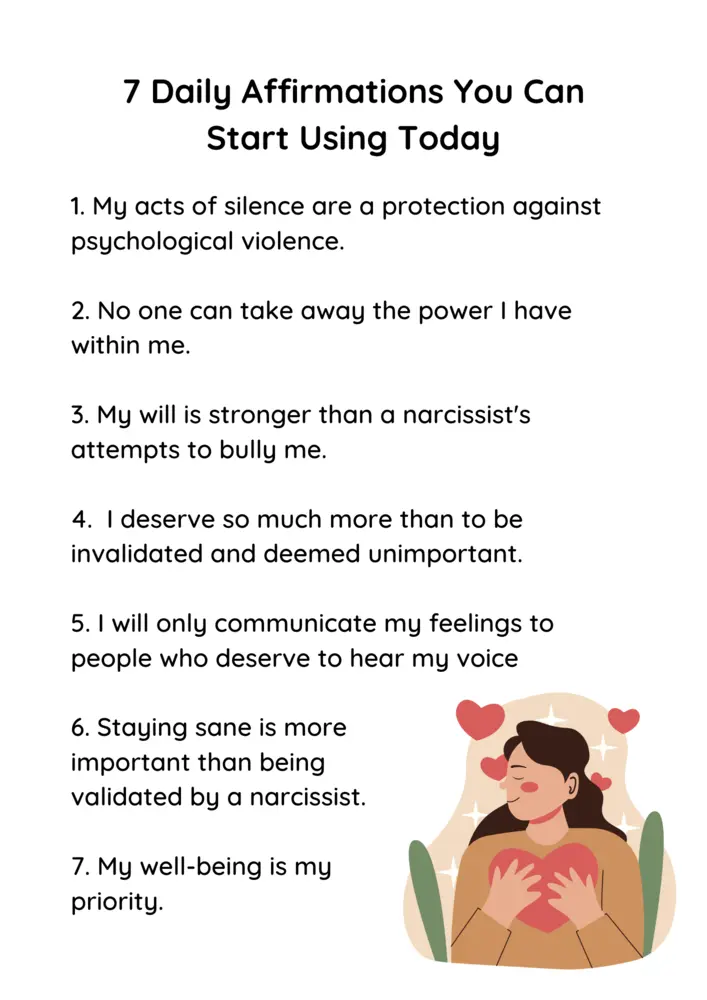A common question that many survivors of narcissistic abuse have is, “How should I respond when the narcissist in my life gives me the silent treatment?”
As a general rule, the best response that you can have to a narcissist’s silent treatment is to not engage with them. Three of the best methods that you can use to do this are the Gray Rock Method, Yellow Rock Method, and the Firewall Method.
This article is going to guide you through all three of these methods so that you can have a response to the silent treatment that keeps you safe.
Use the Gray Rock Method
The Gray Rock Method is a technique that occurs when you restrain yourself from engaging in meaningful interactions with the narcissist in your life.
A meaningful interaction is any interaction that gives the narcissist access to your thoughts, feelings, emotions, or needs.
The silent treatment should be considered as a potential meaningful interaction.
For example, imagine that you are having a normal conversation with the narcissist in your life and they ask you, “Do you think that these jeans look nice on me?”
You respond with, “I think they are a little too tight. Also, they have a stain on the back of them.”

There is nothing wrong with saying this because the jeans are too tight and they have a stain, but because of how fragile narcissists are, they take what you said as an insult.
They say, “I can’t believe that you are being so mean right now. Do you enjoy putting me down?”
Then proceed to give you the silent treatment.
Right now, the narcissist is trying to portray you in a negative light and victimize themselves.
If you were to engage in this interaction, you would be giving them access to your thoughts, feelings, emotions, and needs.
How?
Well, there is nothing that you can say or do to stop the narcissist from trying to portray you in a negative light and victimize themselves.
If you engage, they are only going to try to manipulate you even more.
Instead, you are going to want to consider responding with the Gray Rock Method by simply walking away from the situation.
You see, what the narcissist wants is for you to engage with them so that they can get narcissistic supply and regulate their painful thoughts, feelings, and emotions.
For example, if you were to try to figure out what went wrong, the attention that you would be giving them is narcissistic supply.
It would also give them a chance to abuse and manipulate you, which is how they regulate their painful thoughts, feelings, and emotions.
The Gray Rock Method is designed to make the interactions that you have with them so uninteresting and unrewarding (i.e. no narcissistic supply) that they label you as “boring” and leave you alone.
So by simply walking away, you are restraining yourself from engaging in this meaningful interaction and that means that the narcissist has less opportunities to abuse and/or manipulate you.
So, is the Gray Rock Method the right method for you?
Well, that depends.
We strongly believe that the Gray Rock Method should only be used on narcissists who are emotionally abusive.
If you are dealing with a narcissist who is physically abusive, the Gray Rock Method could cause the abuse to become even more harsh.
Recommended Article:
Our article “How to Gray Rock a Narcissist (3 Simple Steps)” has a lot of helpful information that you can use to learn more about using the Gray Rock Method on a narcissist.
Use the Yellow Rock Method
The Yellow Rock Method is another technique that you can use to respond to a narcissist’s silent treatment.
Just like the Gray Rock Method, the Yellow Rock Method occurs when you restrain yourself from engaging in meaningful interactions with narcissists.
Here’s the catch though…
When you use the Gray Rock Method, there’s a possibility that you could come off as cold, uncooperative, immature, and/or arrogant.

For example, in the previous section we told you that a Gray Rock response could be simply walking away from the narcissist when they gave you the silent treatment.
This response could seem cold, uncooperative, immature, and arrogant, especially to those who don’t know that the narcissist is being manipulative and you are just trying to protect yourself from them.
Generally speaking, there’s nothing wrong with coming off as cold, uncooperative, immature, and arrogant when you are protecting yourself from abuse and manipulation.
But narcissists are very good at portraying others in a negative light.
So, there are some situations where you should try your hardest to not come off as cold, uncooperative, immature, and arrogant.
This is where the Yellow Rock Method comes in.
You see, when you use the Yellow Rock Method, your approach to dealing with abuse and manipulation is much more professional and respectful.
For example, imagine that you are in the middle of a custody battle with a narcissist.
You know that they are looking for ways to portray you in a negative light so you are very careful about the way that you communicate with them.
One day you send them an important message about your children but don’t get a response back because they are giving you the silent treatment.
A Gray Rock response to this silence would be no response at all.
But you can’t afford to come off as cold, uncooperative, immature, and arrogant in the middle of a custody battle because you could lose custody of your kids.
Instead, you are going to want to use the Yellow Rock Method by saying something like, “If I don’t hear back from you by April 2nd, I will assume we are in agreement on this matter,” or “Your refusal to engage in effective communication is noted.”

Yellow Rock responses are professional, straightforward, and respectful.
So, should you use the Yellow Rock Method to respond to the narcissist’s silent treatment?
As a general rule, you want to use the Yellow Rock Method when coming off as cold, uncooperative, immature, and arrogant could have a negative impact on your life or the lives of your loved ones.
Use the Firewall Method
In narcissistic environments, the term “firewall” refers to a defense system that you can build to protect yourself from abuse and manipulation.
Should you use the Firewall Method?
Well, we believe that everyone should build a strong firewall.
That said, the Firewall Method is a fantastic technique that you can use if you are dealing with a narcissist who is physically abusive.
Of course, the best option would be to go No Contact, but if you aren’t in a position to do that right now, then the Firewall Method is a great alternative.
Recommended Article:
This article focuses on methods that you can use to protect yourself from the silent treatment. Our article “How to Protect Yourself From a Narcissist“ focuses on all of the methods that you can use to protect yourself from abuse and manipulation in general.
So, how can you start building a firewall?
As a general rule, there are five layers of protection in a strong firewall that you will need to develop:
- Knowledge
- Radical acceptance
- The concept of the Gray and Yellow Rock Method
- Caution
- Daily affirmations
Step 1: Learn More About Narcissism and Narcissistic Abuse
The first step that you are going to want to take is learning about narcissism and narcissistic abuse.
When you have a comprehensive understanding of narcissism and narcissistic abuse, you are going to be able to stay cool, calm, and collected during the silent treatment.
This is because you are going to understand that you didn’t do anything wrong and that the narcissist is just trying to manipulate you.
That’s not all…
Learning about narcissism and narcissistic abuse is also going to help you (image below)

The list could go on and on but the point is that learning about narcissism and narcissistic abuse is a fundamental requirement for a strong firewall!
Step 2: Practice Radical Acceptance
The second step to building a strong firewall is practicing radical acceptance.
Radical acceptance is a distress tolerance skill that is designed to keep pain from turning into suffering.
When you use radical acceptance, you allow yourself to let go of the need to control situations and focus on your wise mind instead of catastrophic thinking.
Using radical acceptance to manage manipulation and abuse requires you to:
- To let go of the wish for things to be different.
- Accept that you’ll never get closure, justice, answers, or an apology from the narcissist.
- Stop expecting/hoping that the narcissist will change.
- Acknowledge that what you are experiencing is abuse.
The goal of radical acceptance is indifference, lack of interest, concern, or sympathy, towards the narcissist.
Now, indifference doesn’t mean that the abuse you experienced will no longer affect you.
It means that you completely disconnect your thoughts, feelings, emotions, and needs from the narcissist in your life (image below)

You are just completely focused on your own thoughts, feelings, emotions, and needs.
Radical acceptance doesn’t happen overnight.
It takes months, years, and maybe even decades to achieve.
But building a strong firewall requires you to take steps towards radical acceptance.
In an UT Health Houston McGovern Medical School article, Meaghan Warner, LCSW-S has a few tips about how you can practice radical acceptance:
Resistance to accepting a situation causes pain that usually turns into suffering.
This can lead to distress.
Here are a few ways to practice radical acceptance in daily life:
- Acknowledge that you may be fighting reality (ex: it shouldn’t be this way)
- Remain mindful of physical sensations throughout your body (tension and stress)
- Acknowledge that life is worth living, even if there is temporary pain right now
- Repeating to yourself: “I accept this moment as it is” and “Although I and/or my emotions are uncomfortable, I will get through it”
- Understand that the moment is precisely as it should be even though you may not like it
Step 3: Remember the Concept of the Gray and Yellow Rock Method
The third step to building a strong firewall is remembering the concept of the Gray and Yellow Rock Method.
You see, to build a strong firewall, you must be willing to restrain yourself from engaging in meaningful interactions with the narcissist in your life.
Again, the term “meaningful interactions” refers to any interaction that gives the narcissist access to your thoughts, feelings, emotions, and/or needs.
Staying true to this concept is going to help prevent you from:
- Trying to explain yourself to people who won’t listen.
- Trying to defend yourself to people who don’t respect you.
- Being baited into arguments that are designed to portray you in a negative light.
- Being manipulated into justifying, rationalizing, and normalizing abuse.
Step 4: Be Cautious
The fourth step to building a strong firewall is being very careful when sharing your thoughts, feelings, emotions, and needs with other people.
It is normal to want to find someone that you can be vulnerable with.
But just make sure that you are opening up to someone who will protect the vulnerability that you show them, not exploit it.
When interacting with others, you shouldn’t be afraid to take things slowly.

People who are emotionally safe are going to respect the boundary that you’ve set and allow you to slowly open yourself up in a way that is comfortable for you.
Narcissists are going to try to manipulate you into sharing information with them that they can use to gain power and control over you as quickly as possible.
They will give you little bits and pieces of information that make you feel like there’s a level of mutuality when it comes to being vulnerable in the relationship.
Step 5: Practice Daily Affirmations
The fifth step to building a strong firewall is practicing daily affirmations.
One of the ways that narcissists regulate the painful thoughts, feelings, and emotions is by projecting them onto you.
Projection is a defense mechanism that occurs when someone takes parts of their identity that they find unacceptable and place them onto someone else.
A simple example of this could be a cheating husband accusing his wife of cheating instead of taking responsibility for his own actions.
The painful thoughts, feelings, and emotions that narcissists suppress are the parts of their identity that they find unacceptable.
They project them onto you by abusing and manipulating you.
They do this because it allows them to look at you and think to themselves, “They are the one who is unlovable, unwanted, inadequate, weak, and worthless, not me.”
To construct a strong firewall you have to remind yourself on a daily basis that the narcissist’s abuse does not define who you are and/or who you can be.
A fantastic way that you can do this is practicing daily affirmations.

About the Author

Hey, I’m Elijah.
I experienced narcissistic abuse for three years.
I create these articles to help you understand and validate your experiences.
Thank you for reading, and remember, healing is possible even when it feels impossible.
